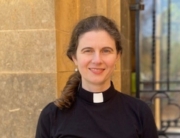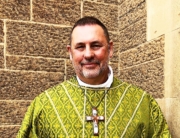Preacher: The Rev’d Canon Jenny Wilson
In the name of God, creating, redeeming, sanctifying, … Amen.
“Sir, we wish to see Jesus.”
In the 12th Chapter of the Gospel according to St. John, Jesus enters Jerusalem on a donkey in the midst of a crowd that waves palm branches to welcome him as they cry their “Hosannas”. They are expecting a Messiah who will overcome all the difficulties in their lives, most particularly the oppressive presence of the occupying Roman forces. Soon after Jesus arrives in Jerusalem, some Greeks who have come to the festival search out Philip, who is from Bethsaida in Galilee, and ask him if they might see Jesus. 22Philip goes and tells Andrew; then Andrew and Philip go and tell Jesus. You might expect a conversation or a meal, you might expect that Jesus will heal or bless these people who have come to search him out. You might expect him to ask them the question that digs into so many souls, “What do you want me to do for you?” But it is too late for all that. Jesus has entered Jerusalem now. Jesus’ hour has come. In John’s Gospel, Jesus’ hour is the time of his death and passion.
And so instead 23Jesus says to them, ‘The hour has come for the Son of Man to be glorified. 24Very truly, I tell you, unless a grain of wheat falls into the earth and dies, it remains just a single grain; but if it dies, it bears much fruit.” He is speaking about his death. But the hint is there that the death is not the end. You want to see Jesus? This is how it works. Death and resurrection. If the grain of wheat dies it bears much fruit. Only for the frightened disciples, they don’t hear the resurrection part. They cannot connect with it. When a human being dies we see no fruit, we see nothing but death. We see only the end of a life. Once Jesus has spoken about his death, it seems impossible that there is anything else to be said.
This Sunday in our cathedral we celebrate the Feast of Transfiguration. This morning we read the story from Mark’s Gospel. And that story rings with connections with our reading tonight from the Gospel according to St. John. The context of the transfiguration story is critical. Jesus, who the disciples hoped would bring in God’s Kingdom, has just foretold his death and resurrection. Six days after the disciples receive such shocking news, Jesus is transfigured in dazzling white light on a mountain and God’s voice is heard naming Jesus “God’s Beloved Son”.
Scripture places such contrasts alongside one another that we might know the deep truth of God’s way – that the way of life and hope and light is often found in dark places. That Transfiguration shares its feast day with the day when we remember the dropping of the first atomic bomb on Hiroshima, is yet another illustration of this theme.
Any reading from John’s Gospel must be placed in the context of the Prologue, the mighty hymn at the beginning of the gospel.
In the beginning was the Word, and the Word was with God, and the Word was God. 2He was in the beginning with God. 3All things came into being through him, and without him not one thing came into being. What has come into being 4in him was life,* and the life was the light of all people. 5The light shines in the darkness, and the darkness did not overcome it. (John 1:1-5)
The light shines in the darkness, and the darkness did not overcome it.
This is transfiguration. This is who Jesus is. “Sir we wish to see Jesus.” You wish to see Jesus? Look in the places of death; look in the places of brokenness. Look where hope seems to have gone. Look at a man dying on a cross. And then hear the transfiguration story. Just after Jesus has predicted his passion and death to his frightened and protesting disciples, those disciples find themselves up a mountain with Jesus and he is bathed in dazzling light and God says what God said at his baptism, just so we can be in no doubt, just so he can be in no doubt, “This is my Son, the Beloved; listen to him!” This is God’s way.
The light shines in the darkness, and the darkness will not overcome it.
Michelle Obama, a week or two ago, in a speech at the Democratic convention in the United States, told a story that is high above politics, a story of God’s transformation, a story of light shining in darkness. Michelle Obama told a story of black people like herself. She spoke of “generations of people who felt the lash of bondage, the shame of servitude, the sting of segregation, but who kept on striving and hoping and doing what needed to be done so that today I wake up every morning in a house that was built by slaves. And I watch my daughters, two beautiful, intelligent, black young women playing with their dogs on the White House lawn.” A black woman wakes up every morning in a house that is the icon of power in one of the most powerful countries on earth, a house that was built by slaves. There is light shining in darkness.
God’s transformation takes time, though. In recent weeks we have heard stories of the most awful violence. Our world, with the violence erupting unexpectedly, almost expectedly now, in cafes, outside police stations, in schools, theatres, shopping centres, and of, course places where trains, buses, and aircraft leave and collect their passengers, our world seems overwhelmed by darkness. In recent weeks, in France, an 85 year old priest is murdered as he celebrates the Eucharist.
In his book, The Crucified God, the theologian Jurgen Moltmann explores the deeply troubling idea that God might be most profoundly revealed in the death of God’s Son Jesus Christ on the cross. “[F]aith in the ‘crucified God’ is … a contradiction of everything men [and women] have ever conceived, desired and sought to be assured of by the term ‘God’. That ‘God’ the ‘supreme being’ and the ‘supreme good’ should be revealed and present in the abandonment of Jesus by God on the cross is something that is difficult to desire’.[1] The redemption of creation is to be found the very place where Jesus’ disciples fled in fear. Moltmann writes, “Our faith begins at the point where atheists suppose it must be at an end.”[2]
The transfiguration took place that Jesus’ disciples at the time of his earthly life and Jesus’ disciples in our time and place might know the deep truth of God’s way. That when we say “Sir, we wish to see Jesus,” we will hear Jesus himself pointing to his cross and passion but we will hear also the story of Jesus’ transfiguration. We will see Jesus and his disciples on a mountain and, on that mountain, we will see Jesus bathed in dazzling light and we will hear God say what God said at Jesus’ baptism, just so we can be in no doubt, just so he can be in no doubt, “This is my Son, the Beloved; listen to him!” This is God’s way.
The light shines in the darkness, and the darkness will not overcome it.
[1] Moltmann, Jurgen The Crucified God (London: SCM Press, 2001), p. 33.
[2] p. 31.



